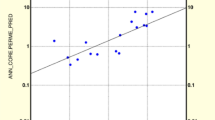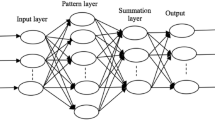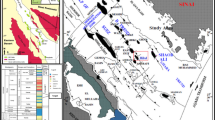Abstract
Integrating discrete distribution of lithofacies into the petrophysical property modeling is essential to preserve reservoir heterogeneity and improve flow modeling. Specifically, various studies have been implemented to model the permeability as a function of well logging data without taking into account the effect of lithofacies, which is rational to produce distinct regression lines given each facies type. In this paper, advanced statistical learning approaches were adopted as an integrated workflow to model the core permeability given well logging records and discrete lithofacies classification for a well in the South Rumaila oil field, located in Iraq. In particular, the probabilistic neural networks was first applied for modeling and predicting the discrete lithofacies classification given the well logging records: neutron porosity, shale volume, and water saturation. Next, smooth generalized additive model (SGAM) was used to model the core permeability as a function of the same well logging records. In addition, the predicted lithofacies was included as a discrete independent variable in the core permeability modeling to provide different regression lines given each lithotype. The SGAM was also modeled for three subset data given each separate lithofacies to verify the efficiency of SGAM and to provide more accurate prediction of permeability. The same procedure of SGAM was completely repeated by the generalized linear model (GLM) to prove the higher effectiveness of SGAM for permeability modeling and prediction. The root mean square prediction error in SGAM was lower than in GLM in all the combined and separate lithofacies models. In addition, the SGAM model overcame the multicollinearity between shale volume and water saturation variables by using the smoothed terms. Finally, making accurate permeability prediction for all wells in the field should ensure capturing the spatial variation and correlation between the data and then preserving the reservoir heterogeneity.


















Similar content being viewed by others
References
Abdulraheem A, Sabakhy E, Ahmed M, Vantala A, Raharja PD, Korvin G (2007) Estimation of permeability from wireline logs in a middle eastern carbonate reservoir using fuzzy logic. Presented at the SPE middle east oil and gas show and conference, Bahrain. https://doi.org/10.2118/105350-MS
Ahmed U, Crary SF, Coates GR (1991) Permeability estimation: the various sources and their interrelationships. JPT 43(05):578–587. https://doi.org/10.2118/19604-PA
Al-Ameri TK, Al-Khafaji AJ, Zumberge J (2009) Petroleum system analysis of the Mishrif reservoir in the Ratawi, Zubair, North and South Rumaila oil fields, southern Iraq. GeoArabia 14:91–108
Al-Mudhafar WJM (2014a) Integrating Markov chains for Bayesian estimation of vertical facies sequences through linear discriminant analysis. Presented at the 76th EAGE conference and exhibition, Amsterdam. https://doi.org/10.3997/2214-4609.20141336
Al-Mudhafar WJM (2014b) Using generalized linear regression of multiple attributes for modeling and prediction the formation permeability in sandstone reservoir. Presented at the Offshore Technology Conference, Houston, Texas. https://doi.org/10.4043/25158-MS
Al-Mudhafar W, Rostami A (2014) Comparative applied multivariate geostatistical algorithms for formation permeability modeling. In: 20th formation evaluation symposium of Japan, Chiba
Al-Mudhafar WJ (2015a) Integrating component analysis & classification techniques for comparative prediction of continuous & discrete lithofacies distributions. Presented at the offshore technology conference, Houston, Texas. https://doi.org/10.4043/25806-MS
Al-Mudhafar WJ (2015b) Integrating Bayesian model averaging for uncertainty reduction in permeability modeling. Presented at the offshore technology conference, Houston. https://doi.org/10.4043/25646-MS
Al-Mudhafar W, Bondarenko MA (2015) Integrating K-means clustering analysis and generalized additive model for efficient reservoir characterization. Presented at the 77th EAGE conference and exhibition, Madrid, Spain (2015). https://doi.org/10.3997/2214-4609.201413024
Al-Mudhafar WJ (2016) Applied geostatistical reservoir characterization in R: review and implementation of permeability estimation modeling and prediction algorithms—Part II. Offshore technology conference, Houston, Texas. https://doi.org/10.4043/26932-MS
Al-Mudhafar WJ, Al-Khazraji AK (2016) Non-parametric adaptive regression splines for multisource permeability modeling in a sandstone oil reservoir. Offshore technology conference Asia, Kuala Lumpur (2016). https://doi.org/10.4043/26431-MS
Al-Mudhafar WJ (2017) Geostatistical lithofacies modeling of the upper sandstone member/Zubair formation in South Rumaila oil field Iraq. Arab J Geosci 10:153. https://doi.org/10.1007/s12517-017-2951-y
Al-Obaidi RY (2009) Identification of palynozones and age evaluation of Zubair formation, Southern Iraq. J Al-Nahrain Univ 12(3):16–22
Al-Obaidi RY (2010) Determination of palynofades to assess depositional environments and hydrocarbons potential, lower cretaceolls, Zubair formation South Iraq. J Coll Educ 5:163–174
Baayen RH (2008) Analyzing linguistic data: a practical introduction to statistics using R. Cambridge University Press, Cambridge
Brockett PL, Chuang SL, Pitaktong U (2014) Generalized additive models and nonparametric regression. Predictive modeling applications in actuarial science. Predict Model Tech 1:367
Chai T, Draxler RR (2014) Root mean square error (RMSE) or mean absolute error (MAE)? Arguments against avoiding RMSE in the literature. Geosci Model Dev 7(3):1247–1250
Chasset PO (2013) Probabilistic neural network for the R statistical language. Software http://flow.chasset.net/pnn/
Cheung V, Cannons K (2003) An introduction to probabilistic neural networks, online. http://www.psi.toronto.edu/~vincent/research/presentations/PNN.pdf
Faraway JJ (2006) Extending the multiple linear model with R: generalized multiple linear, mixed effects and nonparametric regression models. CRC Press, Boca Raton
Friedman J, Hastie T, Tibshirani R (2000) Additive logistic regression: a statistical view of boosting (with discussion and a rejoinder by the authors). Ann Stat 28(2):337–407
Friedman J, Hastie T, Tibshirani R (2001) The elements of statistical learning. Springer, Berlin
Guisan A, Edwards TC, Hastie T (2002) Generalized linear and generalized additive models in studies of species distributions: setting the scene. Ecol Model 157(2):89–100
Hastie TJ, Tibshirani RJ (1990) Generalized additive models, vol 43. CRC Press, Boca Raton
Lacentre PE, Carrica PM (2003) A method to estimate permeability on uncored wells based on well logs and core data. Paper presented at the SPE Latin American and Caribbean Petroleum Engineering Conference, Port-of-Spain, Trinidad and Tobago. https://doi.org/10.2118/81058-MS
Lee SH, Datta-Gupta A (1999) Electrofacies characterization and permeability predictions in carbonate reservoirs: role of multivariate analysis and nonparametric regression. Presented at the SPE annual technical conference and exhibition, Houston, Texas. https://doi.org/10.2118/56658-MS
Mathisen T, Lee SH, Datta-Gupta A (2003) Improved permeability estimates in carbonate reservoirs using electrofacies characterization: a case study of the North Robertson Unit, West Texas. SPE Reservoir Evaluation and Engineering Journal, pp 176–184
Mohammed WJ, Al Jawad MS, Al-Shamaa DA (2010) Reservoir flow simulation study for a sector in main pay—South Rumaila oil field. SPE oil and gas India conference and exhibition, Mumbai
Nashawi IS, Malallah A (2010) Permeability prediction from wireline well logs using fuzzy logic and discriminant analysis. SPE Asia Pacific oil & gas conference and exhibition, Brisbane, Queensland
Perez HH, Datta-Gupta A, Mishra S (2005) The role of electrofacies, lithofacies, and hydraulic flow units in permeability predictions from well logs: a comparative analysis using classification trees. SPE Reserv Eval Eng J 8(02):143–155. https://doi.org/10.2118/84301-PA
Shakir N, Miseer A, Abdulhuseein S (1980) Petrophyscial analysis of well cores of the Zubair formation/South Rumaila oil field. Iraqi National Oil Company Publications, Basra
Silva FPT, Ghani AA, Al Mansoori A, Bahar A (2002) Rock type constrained 3D reservoir characterization and modeling. Paper presented at the Abu Dhabi international petroleum exhibition and conference, Abu Dhabi. https://doi.org/10.2118/78504-MS
Specht DF (1988) Probabilistic neural networks for classification, mapping, or associative memory. In: IEEE international conference on neural networks, pp 525–532
Teh W, Willhite GP, Doveton JH (2012) Improved reservoir characterization in the Ogallah field using petrophysical classifiers within electrofacies. Paper presented at the SPE improved oil recovery symposium, Tulsa, Oklahoma. https://doi.org/10.2118/154341-MS
Yerramilli SS, Yerramilli RC, Vedanti N, Sen MK, Srivatava RP (2013) Integrated reservoir characterization of an unconventional reservoir using 3D seismic and well log data: a case study of Balol field. Presented at the SEG annual meeting, Houston, Texas
Acknowledgements
The author would like to thank the Institute of International Education (IIE) for granting him the Fulbright Science and Technology International Award, which has funded his PhD Research.
Author information
Authors and Affiliations
Corresponding author
Rights and permissions
About this article
Cite this article
J Al-Mudhafar, W. Integrating lithofacies and well logging data into smooth generalized additive model for improved permeability estimation: Zubair formation, South Rumaila oil field. Mar Geophys Res 40, 315–332 (2019). https://doi.org/10.1007/s11001-018-9370-7
Received:
Accepted:
Published:
Issue Date:
DOI: https://doi.org/10.1007/s11001-018-9370-7




